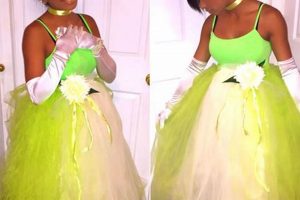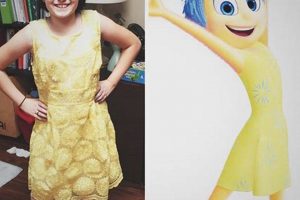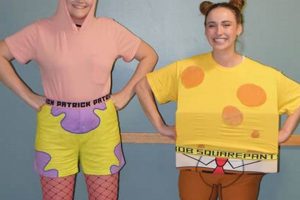Creating a homemade outfit replicating the appearance of the extraterrestrial characters from the Toy Story franchise is a popular activity. This pursuit, often referred to as a do-it-yourself alien costume, typically involves individuals constructing or modifying clothing and accessories to resemble the distinctive green-skinned, three-eyed figures. As an example, individuals might utilize materials like felt, fabric paint, and pre-made garments to craft a recognizable representation of these fictional beings.
The appeal of assembling such a costume stems from several factors. It offers a cost-effective alternative to purchasing commercially produced outfits. It allows for a high degree of personalization, enabling creators to tailor the costume to their specific preferences and size. Furthermore, the process encourages creativity and resourcefulness, promoting engagement with craft skills. Historically, character replication through handcrafted garments has been a common practice, particularly for fans attending conventions, parties, or themed events.
Subsequent discussion will detail various methods and materials suitable for constructing these costumes, address considerations for different age groups, and offer tips for achieving a visually accurate and comfortable final product. The following sections will also explore techniques for incorporating unique design elements and achieving desired levels of detail.
Construction Tips for an Extraterrestrial Garment Recreation
Effective creation of a homemade costume imitating the appearance of the Toy Story aliens requires careful planning and execution. The following guidelines provide insights for achieving a successful result.
Tip 1: Material Selection: Opt for felt or fleece as primary materials due to their affordability, ease of manipulation, and availability in vibrant green hues. Avoid materials prone to fraying or requiring specialized sewing techniques.
Tip 2: Headpiece Construction: Prioritize lightweight materials for the headpiece to ensure wearer comfort. Utilize buckram or interfacing to provide structural support without excessive weight. Secure attachment mechanisms, such as adjustable straps or elastic bands, are essential.
Tip 3: Eye Placement and Proportion: Accurately replicate the distinctive three-eyed configuration. Maintain consistent spacing and ensure that the eyes are proportionally sized relative to the headpiece. Templates and mock-ups can aid in achieving accuracy.
Tip 4: Jumpsuit Design: A simple, loose-fitting jumpsuit pattern is recommended. Employ a zipper or Velcro closure for ease of donning and removal. Consider incorporating elastic at the ankles and wrists to create a more defined silhouette.
Tip 5: Color Consistency: Strive for consistent coloration across all costume components. Utilize fabric dye or paint to achieve uniformity. Ensure that dyes or paints are colorfast to prevent bleeding or fading during wear.
Tip 6: Detailing and Embellishments: Accurate detailing enhances the overall realism of the costume. Consider incorporating elements such as the Pizza Planet logo (if desired) using fabric paint or iron-on transfers.
Tip 7: Safety Considerations: Prioritize safety throughout the construction process. Ensure that all materials are non-toxic and flame-retardant. Avoid sharp edges or protruding components that could pose a hazard.
These tips collectively emphasize the importance of material selection, accurate replication of key features, and adherence to safety standards when creating a homemade extraterrestrial garment recreation. A well-executed plan contributes significantly to the success of this endeavor.
Following these guidelines should provide a solid foundation for creating a satisfactory homemade garment, ready for appropriate functions and events.
1. Material Affordability
Material affordability is a central tenet in the successful execution of a do-it-yourself alien from Toy Story costume project. Cost-effectiveness directly impacts accessibility, determining whether the costume is within reach for a broad audience. The choice of materials, therefore, becomes a crucial decision point. For instance, selecting felt over more expensive fabrics like designer cotton or specialized synthetics enables significant cost reduction, permitting individuals with limited budgets to participate in the creative process. This accessibility is a primary driver behind the popularity of homemade costumes.
The practical significance of material affordability extends beyond initial purchase costs. Cheaper materials often correlate with ease of handling and manipulation, simplifying the construction process. Felt, for example, requires minimal sewing expertise and can be readily cut and glued, reducing the need for specialized tools or professional assistance. This simplified construction, in turn, lowers the overall time investment and skill barrier, making the project manageable for individuals with limited experience in crafting. Consider a parent creating a costume for a child’s school event; the ability to use inexpensive, readily available materials significantly streamlines the project.
Ultimately, material affordability dictates the practicality and widespread adoption of do-it-yourself alien from Toy Story costumes. While elaborate designs using premium materials are possible, the core appeal lies in the ability to create a recognizable and engaging costume without incurring significant financial burden. Balancing cost with visual accuracy and durability is a critical consideration, ensuring the project remains accessible and enjoyable for a wide spectrum of enthusiasts. This aspect highlights the foundational role of budgetary awareness in successful project completion.
2. Construction Simplicity
Construction simplicity is a paramount consideration when undertaking a do-it-yourself project focused on replicating the alien characters from the Toy Story franchise. The inherent complexities of costume creation can present a significant barrier to entry; therefore, streamlining the design and fabrication process is essential for widespread accessibility and successful project completion.
- Simplified Pattern Design
The foundation of construction simplicity lies in the adoption of simplified pattern designs. Avoiding intricate cuts, complex seams, and advanced sewing techniques is crucial. A basic jumpsuit pattern, for instance, can be easily modified to resemble the alien’s form, requiring only minimal alterations. This approach contrasts with more elaborate costumes that necessitate specialized skills and tools, lowering the entry point for amateur creators.
- Adhesive Assembly Techniques
Traditional sewing methods can be replaced, or
supplemented, by adhesive assembly techniques to further enhance construction simplicity. Fabric glue, hot glue, and fusible interfacing provide alternative methods for joining fabric pieces, eliminating the need for extensive sewing machine usage. These techniques are particularly beneficial for attaching smaller details, such as the alien’s eyes, or securing edges, thereby reducing the time and skill required for completion. - Prefabricated Component Integration
Integrating prefabricated components represents another strategy for simplifying the construction process. Ready-made elements, such as green T-shirts, leggings, or even inflatable suits, can serve as the base for the costume, drastically reducing the amount of custom fabrication required. These elements provide a readily available foundation that can be further embellished and modified to achieve the desired aesthetic, thus expediting the construction process and lowering the overall complexity.
- Minimal Detail Emphasis
Construction simplicity can also be achieved by strategically minimizing the level of detail incorporated into the costume. Focusing on the character’s most recognizable features, such as the green skin, three eyes, and distinctive antenna, while omitting less critical details, simplifies the creation process without significantly compromising the overall recognizability of the costume. This approach allows creators to prioritize efficiency and focus on the elements that contribute most to the costume’s identity.
The interconnectedness of these facets highlights the multifaceted nature of construction simplicity in the context of creating an alien from Toy Story character reproduction. The cumulative effect of simplified pattern design, adhesive assembly techniques, prefabricated component integration, and minimal detail emphasis is a significant reduction in the complexity and time investment required, making the project accessible to a wider range of individuals. For instance, a parent preparing a costume for a child’s event can leverage prefabricated green apparel and adhesive techniques to create a recognizable and enjoyable costume without extensive sewing experience.
3. Recognizable Accuracy
Recognizable accuracy is a pivotal determinant in the success of any “alien from toy story costume diy” endeavor. It represents the degree to which the constructed costume effectively replicates the salient visual characteristics of the characters from the Toy Story franchise, thereby enabling immediate identification by observers familiar with the source material. The pursuit of recognizable accuracy directly influences material selection, construction techniques, and the overall aesthetic impact of the finished product.
- Proportional Fidelity
Proportional fidelity refers to the accurate representation of the alien’s body proportions, particularly the head size relative to the torso and limbs. Discrepancies in these proportions can significantly detract from the costume’s overall recognizability. For instance, a headpiece that is disproportionately small may render the costume generic and less identifiable as a specific character from the Toy Story series. Accurate scaling, often achieved through careful measurement and pattern drafting, is crucial for maintaining proportional fidelity.
- Color Palette Consistency
Color palette consistency involves adhering to the established color scheme of the alien character, primarily the characteristic green hue of the skin. Deviations from this color palette, such as using a shade of green that is too light or too dark, can diminish the costume’s visual accuracy. Employing color swatches and referencing official character artwork can aid in selecting materials and dyes that closely match the intended color palette, enhancing visual fidelity. An example includes matching the material with a Pantone value similar to the character.
- Facial Feature Replication
Facial feature replication centers on the accurate representation of the alien’s distinct facial characteristics, most notably the three eyes and mouth. The size, shape, and placement of these features significantly contribute to the character’s recognizability. Inaccurate eye placement or an improperly shaped mouth can distort the character’s appearance and impede identification. Templates and reference images can be utilized to ensure precise replication of these key facial features, maximizing visual accuracy. A simple detail like the shape of the mouth can dramatically alter the perception of the costume.
- Costume Element Mimicry
Costume element mimicry encompasses the replication of specific details associated with the alien’s attire, such as the collar or any other distinguishing articles. While the aliens’ design is relatively simple, the presence or absence of these defining elements affects recognizability. Fabricating a collar or carefully replicating specific markings contributes to visual fidelity. The absence of even minor details can reduce the impact.
These considerations collectively underscore the importance of recognizable accuracy in homemade alien costumes. Attending to proportional fidelity, color palette consistency, facial feature replication, and costume element mimicry enhances the costume’s visual fidelity and ensures its immediate identification as a character from the Toy Story franchise. When “alien from toy story costume diy” projects prioritize these elements, the costumes are more likely to be successful, providing a rewarding and engaging experience for both the creator and the observer.
4. Safety Standards
Safety standards constitute a critical, often overlooked, element in the domain of do-it-yourself alien costumes inspired by the Toy Story franchise. The creation and utilization of such costumes, particularly when intended for children, necessitate adherence to established safety protocols to mitigate potential hazards. The cause-and-effect relationship is direct: inadequate safety measures during construction or wear can result in physical injury or discomfort. Prioritizing safety standards is not merely a recommendation but a fundamental aspect of responsible costume creation. For example, using non-breathable materials can lead to overheating, while poorly secured costume elements can pose choking risks, especially for younger children.
Adherence to safety standards involves several practical considerations. Material selection must prioritize non-toxic, flame-retardant options to minimize the risk of allergic reactions or fire hazards. The structural integrity of the costume should be rigorously assessed to prevent tearing or detachment of components during wear, which could lead to trips or falls. Eyeholes and headpieces must be designed to ensure adequate visibility and ventilation to prevent disorientation or suffocation. Furthermore, embellishments such as glitter or small plastic parts should be securely attached to preclude accidental ingestion or inhalation. The practical application of these standards translates to a safer and more enjoyable experience for the wearer.
In summary, safety standards are an indispensable component of any do-it-yourself alien from Toy Story costume project. Neglecting these standards can have detrimental consequences, ranging from minor discomfort to serious injury. A comprehens
ive understanding and diligent implementation of appropriate safety measures is paramount to ensure that these costumes are not only visually appealing but also safe and suitable for their intended purpose. The challenge lies in balancing creative design with pragmatic safety considerations, thereby fostering a responsible and conscientious approach to costume creation.
5. Customization Potential
Customization potential represents a significant factor driving the popularity of creating alien costumes inspired by the Toy Story franchise. The inherent simplicity of the character design allows for considerable individual interpretation and personalized embellishment, enhancing the wearer’s connection to the costume and fostering creative expression.
- Fabric Texture and Pattern Variation
The selection of fabric extends beyond basic color and material type. Texture and pattern variations offer avenues for customization. For example, using a subtly textured fleece instead of plain felt introduces visual interest without compromising recognizability. Similarly, incorporating a subtle repeating pattern, such as small stars or geometric shapes, adds a unique element. The impact of these choices provides opportunities for creative control and aesthetic refinement, resulting in a more personalized costume.
- Accessory Integration and Design
The addition of accessories provides significant customization potential. While the aliens themselves have limited accessories, interpretation can be applied to the costume. For instance, adding a miniature Pizza Planet box as a prop creates a thematic link. A custom-designed backpack, embellished with alien-themed patches or drawings, can serve as both a functional accessory and a personalized detail. These additions enhance the costume’s narrative and visual appeal.
- Alteration of Anatomical Proportions
While maintaining recognizable accuracy is important, slight alterations to anatomical proportions can introduce unique stylistic elements. For example, exaggerating the size of the head or eyes subtly alters the character’s appearance without compromising its identity. Altering the length or shape of the limbs can also create a more stylized or cartoonish effect. Such modifications require careful consideration to avoid distorting the character beyond recognition but offer avenues for creative expression.
- Lighting and Electronic Component Incorporation
The integration of lighting and electronic components represents a more advanced customization option. Adding LED lights to the eyes or antenna enhances the costume’s visibility and creates a visually striking effect, particularly in low-light environments. Incorporating sound effects, such as snippets of dialogue from the Toy Story films, adds an auditory dimension to the costume. These additions require technical expertise but significantly enhance the costume’s overall impact and uniqueness.
Customization Potential, therefore, is an essential aspect to costume projects. Through manipulation of Fabric Texture, Accessory Integration, Anatomical Proportions, and technical Components, one is able to make the project that much more unique. Each element plays an important role in the costume project.
Frequently Asked Questions
This section addresses common inquiries regarding the creation of homemade costumes replicating the extraterrestrial characters from the Toy Story franchise. The information provided aims to clarify key considerations and address potential challenges associated with such projects.
Question 1: What are the most suitable materials for constructing a durable yet affordable alien costume?
Felt and fleece represent practical choices due to their cost-effectiveness and ease of manipulation. These materials offer a balance between durability and affordability, rendering them suitable for both novice and experienced costume creators.
Question 2: How can accurate proportions be achieved when replicating the alien’s distinctive three-eyed head?
Employing templates and mock-ups is crucial for maintaining proportional accuracy. Prior to final construction, create scaled drawings or physical prototypes to ensure correct placement and size relationships of the eyes and other facial features.
Question 3: What closure methods are recommended for a child’s alien jumpsuit to ensure ease of wear and removal?
Velcro closures and zippers represent practical options for children’s costumes. These methods offer ease of use while maintaining a secure fit. Avoid buttons or snaps that may pose a choking hazard for younger children.
Question 4: How can the costume’s color consistency be maintained across different materials and components?
Fabric dye or paint can be utilized to achieve color uniformity. Ensure that dyes or paints are colorfast to prevent color bleeding or fading during wear or washing. Test color compatibility on scrap material prior to application.
Question 5: What safety precautions should be observed when incorporating accessories or embellishments into the costume?
All accessories and embellishments must be securely attached to prevent detachment and potential ingestion. Avoid sharp edges or protruding components that could pose a risk of injury. Utilize non-toxic adhesives and paints to minimize potential allergic reactions.
Question 6: How can ventilation be optimized in a full-body alien costume to prevent overheating and discomfort?
Incorporate breathable fabrics into the costume’s design, particularly in areas covering the torso and head. Ensure adequate ventilation holes are strategically placed to promote airflow and prevent the buildup of heat and moisture. Avoid tight-fitting headpieces that restrict ventilation.
In summary, successful “alien from toy story costume diy” ventures hinge upon careful material selection, precise replication of character features, adherence to safety guidelines, and a commitment to ensuring wearer comfort. Addressing these considerations proactively enhances the likelihood of achieving a visually accurate and functionally sound final product.
The subsequent section will explore advanced techniques for enhancing the visual impact and durability of homemade alien costumes.
Conclusion
The preceding discussion explored the multifaceted aspects of the “alien from toy story costume diy” process. It emphasized the significance of material affordability, construction simplicity, recognizable accuracy, adherence to safety standards, and the potential for individual customization. Each facet contributes to the overall viability and success of such projects, influencing the aesthetic outcome and the wearer’s experience.
The creation of a homemade costume replicating the Toy Story aliens presents a unique opportunity to engage in creative expression while honoring a beloved fictional universe. Successful execution requires thoughtful planning, diligent execution, and a commitment to balancing artistic vision with practical considerations. By addressing the challenges and embracing the opportunities outlined, individuals can create visually compelling and functionally sound costumes that effectively capture the spirit of these iconic characters.







